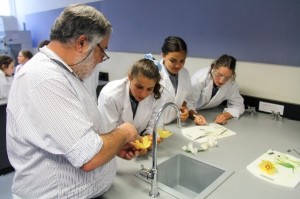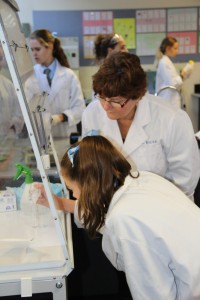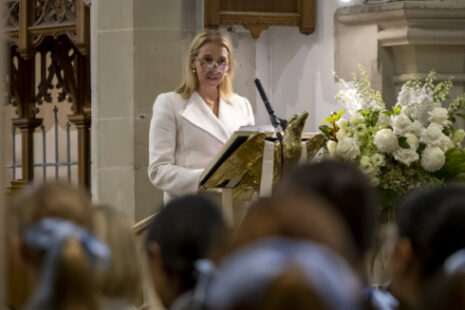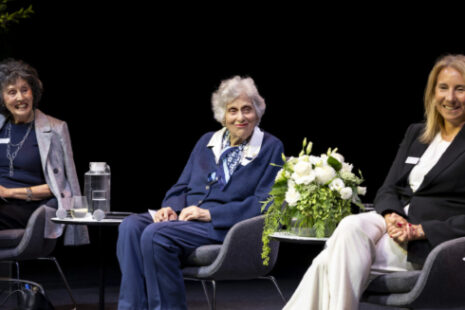Propagation Provides Practical Education
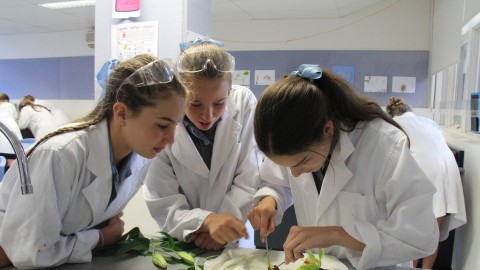
The Propagation Education Conservation Exploration (PECE) Program has generated many diverse learning opportunities for our students
In 2012 Dr John Varigos approached the Science Faculty at St Catherine’s School regarding participating in a joint project with the Australian Native Orchids Society (ANOS) to educate Year 8 students about native orchid propagation and conservation.
Dr Varigos’s idea for the program was based on an orchid propagation program at the Writhington School in the United Kingdom. It was a logical extension to the Horticulture programs already developed in Year 7 and so the St Catherine’s Propagation Education Conservation Exploration Program (PECE) commenced.
The program, now in its fifth year, involves an introductory talk with Dr Varigos, where students are introduced to the diverse world of orchids. The flower structure and pollination of orchids are compared to those of other types of flowering plants. Also discussed during this session is the loss of orchid habitat and conservation. Students dissect a lily flower and an orchid flower, as well as planting orchid tubers. The growth and development of the flowers are followed during the year by the students.
Students are always amazed to find that orchids have many structures enabling them to attract pollinators, such as disguising flowers as female wasps, so as to trick an unsuspecting male wasp to call by and pick up pollen or passing it onto another flower. This completes the process of pollination and fertilization in the reproduction of orchids.
Students are also introduced to the propagation of native orchids and why this must be done in aseptic conditions.
The next stage of the program involves students completing a practical session, where they use a Lamina Flow Unit to provide an aseptic (sterile) environment in which to propagate native orchid seeds. Native orchid seeds are very small, in fact dust like in appearance. They are very different to most seeds that are much larger such as the broad bean. The large seeds are able to carry a food supply inside to assist with germination, orchid seeds however rely on a symbiotic relationship with a special fungus that lives in the soil in their natural habitat. To simulate these conditions in the laboratory a special agar medium is produced and this is where the orchid seeds are placed. This is called plating and at all stages the equipment, medium and the students must be kept sterile to avoid contamination of the agar. If contamination does occur the seeds will not germinate.
The plated orchid seeds are then placed under grow lights in the laboratory where their growth is tracked. After a period of six months the seeds are re-flasked to enable future growth. Further along the orchids are planted in pots ready to be released back into the natural environment.
In early September the Year 8 students undertake a field trip to the Anglesea Heathland, home to over 80 species of native orchids. Under the guidance of Dr Varigos, Margaret McDonald and volunteers from ANGAIR (Anglesea, Aireys Inlet Society for the Protection of Flora and Fauna), students identify conservation issues relating to the area as well as exploring, identifying and photographing the orchid species in bloom. The annual photography completion has become a highlight of this day.
The evolution of the program has generated many diverse learning opportunities for our students. The practical skills of the Year 8 students have developed with the guidance of the laboratory staff in particular Ms Wendy Stevens. She along with Mrs Virginia Midgley and I have received expertise tutelage from Mr Richard Thomson, an expert in this field, who provided us invaluable advice regarding the aseptic propagation of the native orchids as well as sourcing materials and suppliers for the program.
This all culminated in our presentation of the St Catherine’s School P.E.C.E. Program with Dr Varigos at the ANOS National Orchid Conservation Symposium in 2013. This was a privilege as native orchid experts and academics in the field were fellow presenters. The program has been embedded in the Year 8 Science curriculum in the Biological and Science as Human Endeavour Strands.


